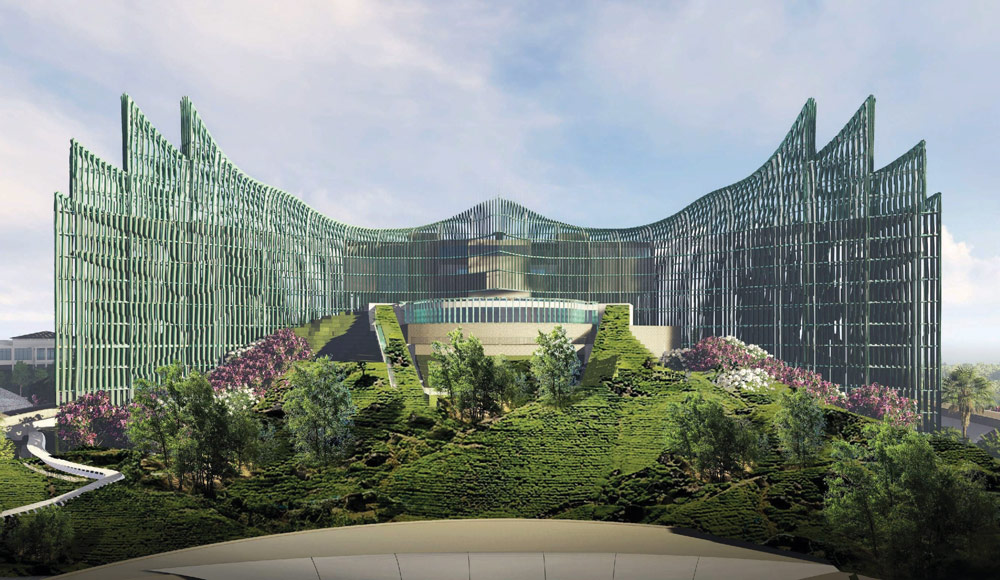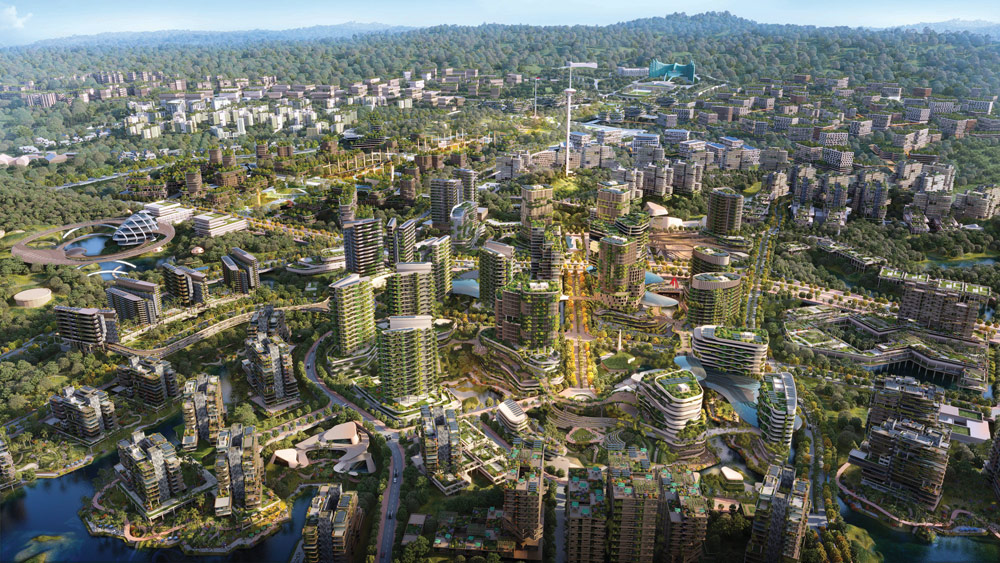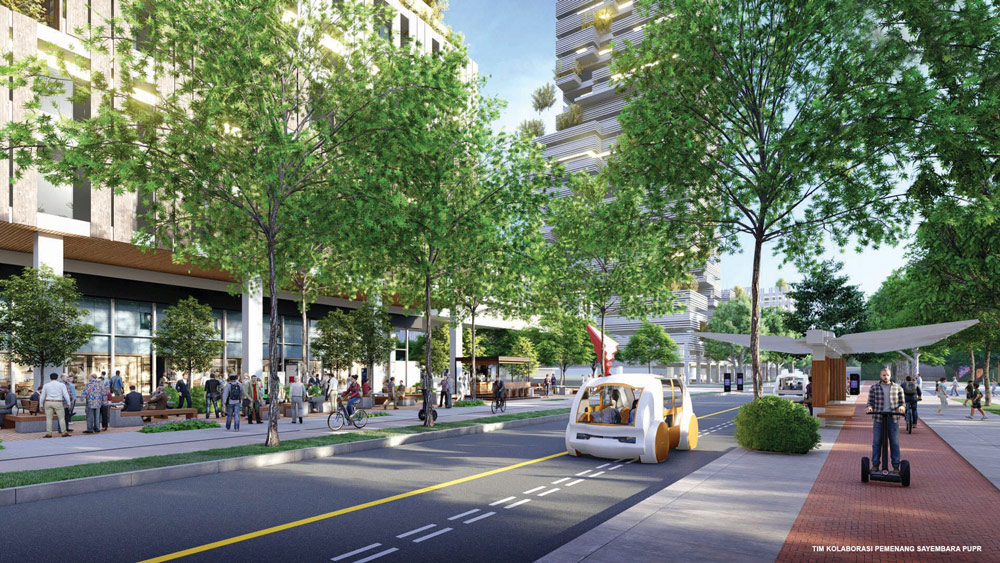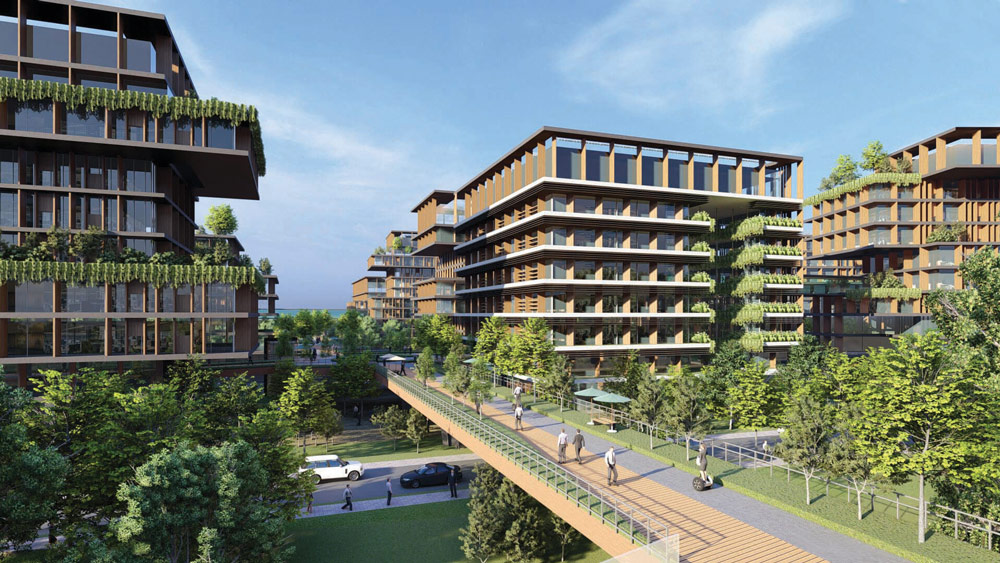The debate over the transfer of the national capital from Java to Kalimantan ended with the passage of Law Number 3 of 2022 concerning the National Capital (IKN Law). This law was signed and officially published on 15 February 2022, which established the Nusantara Capital Authority, a ministry-level organization that oversees the Special Capital Region of the Archipelago Government, and the designation of the name Nusantara (hence the name Ibu Kota Nusantara IKN) as the capital of the country. With the passing of the law, the new national capital will become the seat of the central government as well as delegations from other countries and international organizations and institutions.

The transfer of the capital from Jakarta to IKN has been declared as an aspiration to become the most sustainable city in the world and as a driver of the Indonesian economy in the future. It is also hoped that IKN will become a symbol of national identity that can accommodate the diversity of the Indonesian population. These are lofty aspirations, as are the eight guiding principles of the nation’s future capital, based on:
- Bhinneka Tunggal Ika (Unity in Diversity),
- Active and easy to Connect,
- Circular and Resilient,
- Comfortable and Convenient through Technology,
- Safe and Cheap,
- Carbon-Efficient,
- Economic Possibilities For All, and
- Reflecting The Goals Of The Nation.
The concept is that IKN is the government’s way of carrying out inclusive economic development by creating a new magnet for economic growth so that it does not rely on Java Island. IKN Nusantara should also be a symbol of national identity, green economy, green energy, smart transportation, and efficient and effective governance.
These are exceptional and exacting ideals and have been analysed and examined by academics and journalists in a series of reports that were published in Kompas, Tempo and other publications. Here are some of the results, extracted and summarised.
Development and Transfer of IKN: The Hopes and Challenges
Administratively, the IKN area is located in two existing regencies, namely Penajam Paser Utara Regency and Kutai Kartanegara Regency, the IKN Region is located north of Balikpapan City and south of Samarinda City with a land area of approximately 256,142 hectares and a seawater area of approximately 68,189 hectares.

The transfer of IKN to Kalimantan is based on several considerations of regional advantages, namely:
- Encouraging the development of Eastern Indonesia to promote greater regional equality;
- Changing the development orientation from Java-centric to Indonesia-centric;
- The availability of large areas of land allows the building of a new capital city with a green area that is more dominant than the built-up area;
- Reducing the burden on Java and Jabodetabek (Greater Jakarta)
- Utilising its strategic location in the middle of Indonesian territory and on the Indonesian Archipelago Sea Channel
- It will have a relatively complete infrastructure;
- The location is adjacent to two supporting cities that will also develop, namely Balikpapan City and Samarinda City;
- Availability of adequate government-controlled land for the development of IKN;
- Minimal risk of natural disasters.
IKN Nusantara is a milestone of the program called Advanced Indonesia 2045 which is supported by Indonesia Centric development that supports the creation of inclusive growth and at the same time sends a message to the world that IKN Nusantara is not just about moving the physical capital and government offices, but more than that, it is Indonesia’s effort to build a new smart city that is competitive at the global level, and building a new locomotive for Indonesia’s transformation based on innovation, technology and the green economy. IKN Nusantara will be supported by Smart Transportation, Smart Grid Technology, Green Building Technology.
IKN’s Focus on Sustainable Development
IKN will embody smart transportation, which is a city transportation system designed based on the integration of public transportation, bicycle, and pedestrian development by implementing an Integrated Information System, Intelligent Transport System, and Innovative Public Transportation Network as well as promoting fuel- efficient and environmentally friendly vehicles (electric cars).

In terms of energy utilization, IKN Nusantara will use Smart Grid Technology to utilize the sun as a source of electricity, replacing electricity sourced from coal to reduce the amount of CO2 and be able to control the distribution of electrical energy during peak hours with electricity distribution using an underground cable network.
In addition, the use of green buildings is characterised by increasing energy efficiency, reducing water and material consumption, and improving health and the environment, the use of energy-efficient and environmentally friendly equipment, the use of renewable energy, improving air quality with heating and cooling systems, and the use of natural lighting systems. The Smart City will make it a healthy, efficient, and productive city friendly to pedestrians and bicycle users and provide security and health services as well as new smart metropolis education that is able to become a world-class innovation centre.
IKN’s Challenges
The construction of IKN does not mean that there are no challenges. According to Tempo Magazine, there are 4 challenges in the construction of IKN:
First, integration is needed based on basic conditions where all design and development must be based on current topographic and geological conditions.
Secondly, land grading and all infrastructure plans should refer to drainage plans to prevent flood disasters.
Thirdly, coordination of underground infrastructure is required. According to Takehiro, one of the things that is considered is the security of the area of free space or right of way (ROW), especially for manholes and larger structures such as sewer lifting pumps.
Fourth, it is necessary to prepare space to ensure the accessibility of future expansion. One of them, said Takehiro, is the need for land for public transportation services such as bus stops and road utilities such as lights and CCTV and finally construction quality assurance.
Based on some of the findings above, the author also sees IKN in the process of building only focuses on smart cities but forgets the true intention of sustainable development. This is in line with what Aitoh Nur Rohma said in his writing in tempo.co (2022) that this effort to move the capital does not meet the principles of the Sustainable Development Goals (SDGs). Mainly, the relocation of the capital does not meet the principles of justice, participation, and gender equality (mainly women) which are important foundations in sustainable development. The construction of a new capital city is, in his opinion, not favourable to the environment or future generations, did not involve the consent of the people, and adds homework for the government in the adaptation of gender welfare in the new capital.
He continued saying that moving the capital to East Kalimantan increases the risk of deforestation because it requires clearing new land and space for populations coming from Jakarta. Also the principle of participation reflects democratic practices in development which means that development must provide a platform for community involvement. However, the government did not involve equal public participation in deciding on the transfer of the capital and does not represent the public interest (Ruggerio, 2021).
In addition, he claimed that the Ministry of National Development Planning was not transparent in its study on the transfer of the capital. As a result, public knowledge of the discourse of moving the capital was limited. This made the public unable to directly criticize the scientific review carried out by the government.
The Benefits of the Transfer According to Bappenas
Note: Bappenas is shorthand for the Ministry of National Development Planning of the Republic of Indonesia

The impact of moving the new capital on the national economy is with a Real GDP of +0.1%, The positive effect is due to the use of potential resources that have not been utilized so far. The relocation of the national capital to regions outside Java Island will not cause economic contraction in other regions if the alternative location of the capital city has adequate resources and the linkage of positive economic activity in other regions The transfer of the capital to alternative provinces will cause the economy to diversify more towards more labour-intensive sectors, to help to reduce the gap between income groups, both at the regional level and the national level. The transfer of the national capital to a new province will create a wider investment boost in other regions, The economic linkage of the new capital province with other surrounding provinces will be one of the drivers of investment in other provinces.
On the other hand, there are several risks from moving IKN out of Java. Risks are mainly related to the readiness of the destination area in the aspect of infrastructure needed to support government administration. From the financing aspect, although the government has stated that only 19.2% of the total budget needs of IDR 446 trillion are borne by the state budget, there is a risk of increasing the burden on the state budget if there is a failure of development carried out by the private sector. So, to ensure the development of a new IKN, Bappenas plans to provide incentives for business actors to invest. Bambang Brodjonegoro estimates that nationally there will be an increase in trade flows by 50% as a result of the growth of industrial estates in IKN which are connected to other regions in Indonesia.
However ‘New city’ development projects demand massive infrastructure provision, and they usually have long-term risks, especially from the under-performance of projects that don’t exactly follow the expected specifications. On the other hand, the private sector certainly expects the realization of profits at least matching the calculations promised at the beginning of the project. With the principle of risk sharing, the government must pay attention to cooperation agreements with business entities or the private sector so that the quality of the new IKN infrastructure will be the highest quality.
Social Impact
According to Suyanto (2022) in his article published in jawapos, he said that the transfer of IKN will affect the social impact of the community, and there are several problems that need to be anticipated. First, how to ensure that the development of IKN Nusantara does not give birth to a process of marginalization of the local population. So far, a lot of evidence shows that the development and industrialization that occurs in an area is not matched by the readiness of local residents to be able to participate in the ongoing development process. With limited educational background and other structural limitations, often the locals are just spectators. They cannot be accommodated in the development process even the construction of IKN Nusantara (Jawapos, 2022).
Second, it relates to the possibility of transferring ownership of production assets and socioeconomic capital of the community in the regions. In the process of developing IKN, it is certain that what happened was not only infiltration and invasion of migrants from outside in large numbers. But also, the possibility of a succession process of ownership of local resources. The presence of the state, the private sector, and migrants will certainly have a strong temptation for local residents, whose conditions are less favourable, to immediately release their assets. While not cotravening prevailing market laws, such economic transactions which are detrimental to the survival of the local population are very likely. Third, there is the possibility of cultural shock due to the process of urban culture penetrating into rural areas around IKN Nusantara. A gigantic new city, not only in terms of size, but also lifestyle, will undoubtedly have a significant social impact on people’s way of thinking and social activities.
Experience has shown that the presence of migrants in an area certainly does not only have a tremendous economic impact, but it also offers new, more permissive lifestyles, more contractual relationship patterns, and so on. Probably all different from the customs, norms, and values of the local community. This means that there are two potential socio-economic impacts, namely the loss of both livelihoods and housing, especially for those who work and live in plantation forest areas.
Ecological Impact
According to experience, large construction projects are constantly dealing with environmental issues, not to mention the matter of indigenous peoples’ management rights to their customary land. And despite the existence of research on environmental impact, developers often ignore this research in favour of reducing the cost of the project they are working on. As a result, from an ecological perspective, the growth of Kota Nusantara is unlikely to be pro-environment, despite the many claims to the contrary. And the Nusantara City area of Penajam Paser Utara Regency will certainly face changes to its ecology with detrimental effects on the richness of existing species. The issues that always seem to arise are that mega projects usually fail to prioritize environmental safety in the name of efficiency.
Moreover, a development that is funded or prioritized by the private sector will tend to be full of political cartels that tend to commit fraud and be manipulative which causes failure and especially environmental damage. Instead of making IKB a city for all those with smart cities and green buildings, it will have an impact on failure in every sector (Herdiawan, 2021).
President Joko Widodo (Jokowi) said that the transfer of IKN from Jakarta to East Kalimantan was bound to always look at environmental aspects. He emphasized this because the ultimate goal of the new national capital is a green smart city. “I have often said that the development of IKN begins with rehabilitating existing forests”, and a plan was made to fulfil it.
Nusantara in 2045 Until the Future
So it is claimed that the area around IKN can return to its original function, namely as a tropical forest and not a monoculture forest with Mentawir Nursery in the next 6-7 months expected to be able to produce 15-20 million seedlings of nyatoh, meranti, lime, agarwood, and guava trees. After that millions of seedlings produced from the Mentawir Nursery will be brought to IKN and then planted in critical lands. This solution is to answer several NGOs who criticize the transfer of IKN on the grounds it will damage the environment.
In addition to economic potential, the transfer of IKN also has risks that must be anticipated by the Government. The first risk is related to financing from the need to transfer IKN. The transfer of IKN also has risks, especially from financing needs. The financing scheme for the construction of a ‘new city’ and its infrastructure has long-term risks, especially as a government centre. The government should pay attention to aspects of regional planning and spatial planning so that land use can be effective and minimize the possibility of inflation from uncontrolled land price increases (Silalahi, 2019; Nahak, 2019).
Based on a survey conducted by researchers by sampling several residents in East Kalimantan, the survey results found that the ecological impact was greater than the economic impact and so was the social impact greater than the economy. This means that the economy is not the only aspect that has a significant impact on the people of East Kalimantan but instead the impact of IKN development will have more impact on its ecological and social aspects.
Development Timeline of IKN

This is the approximate plan:
From 2025 to 2035: Developing the next phase of the city, including the innovation and economic centres, completing the relocation of IKN government offices, developing priority economic sectors, implementing incentive systems for priority economic sectors, and achieving the Sustainable Development Goals (SDGs).
From 2035-2045: Focus on expanding urban development and completing inter- and inner-city connectivity, the No. 1 FDI destination for priority economic sectors in Indonesia, the top 5 major destinations in Southeast Asia for global talent, encouraging a sustainable utility network by implementing circular economy enablers, developing innovation and talent development centres.
In 2045: Solidifying IKN as a World City For All, focus on being the world’s leading city in terms of competitiveness, top 10 livable cities in the world, achieving net zero-carbon emissions and 100% renewable energy at installed capacity – the first city in the world with a population of more than 1 million people to reach the target
Conclusions
Based on the results of the analysis above, it can be concluded that the IKN development is focused on: smart transportation, smart grid, and green buildings and the building process must meet the principles of fairness, participation, and gender equality (especially women) which are important foundations in sustainable development.
But there are several challenges faced by IKN in the future, based on findings in the mass media:
First, integration is required based on basic conditions in which all design and construction must be based on current topographic and geological conditions, with land grading and all infrastructure plans including drainage plans to prevent flood disasters,
Secondly, coordination of underground infrastructure is required. According to Takehiro, one of the things that are considered is the security of the area of free space or right of way (ROW),
Thirdly, there has to be serious consideration as to the social and economic impact on the indigenous people as well as the potential environmental impact through deforestation.
Fourth, the government should take special notice of the challenges faced by similar projects in the past where there are serious lessons to be learnt from.
Lastly, in moving the capital and having such a comprehensive and detailed plan for IKN, there should be an equally comprehensive and detailed plan for Jakarta based on its rehabilitation and revitilisation as the nation’s centre of culture, trade and industry.
That surely is equally important?
Enjoyed this piece? Check out our other articles on Indonesia’s capital:






